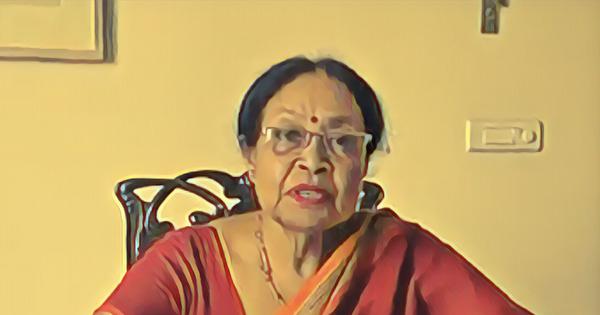
Aruna Chakravarti’s exceptional skills as both a translator and a writer of meticulously researched historical fiction are widely acknowledged and evidenced by her much-acclaimed oeuvre so far. This time, however, she has mobilised her art of translation to cast some light on the plight of the Dalits of Bengal, more specifically, of Dalit women, who confront a three-pronged dilemma: the stigma of their caste, gender-based injustice, and ubiquitous poverty. The result is Rising From the Dust: Dalit Stories from Bengal.
Many Bengals
For this anthology Chakravarti has translated 12 stories spread across a century, including works by both contemporary Dalit writers and those written about the community by non-Dalit writers who wrote sensitively about the condition of Dalit women. Apart from the sheer enjoyment of reading these stories, which I shall deal with later, I must mention here that for me, this book, at many levels, is an eye-opener and offers multiple layers of pleasure, like a matryoshka doll, encasing within itself a variety of linked worlds of personal and literary associations and significance.
I come to it not just as a reader but as an expatriate Bangladeshi-Italian, and an anglophone writer and translator myself. There is also my background of being born in undivided Pakistan, and growing up in both East and West Pakistan, which enables me to relate to the stories where Bangladesh or East Bengal is mentioned.
Also, to read in this anthology the works of some of the contemporary writers of Bengali Dalit literature, like Manoranjan Byapari, Manohar Mouli Biswas or Nakul Malik, all new to me and all born in East Pakistan, gives me a special insight into, at least, the geographic if not the economic or social circumstances of their remembered world. This is true also of the great Mahasweta Devi, many of whose stories about Adivasis I helped translate into Italian, and had the pleasure of meeting her during a film festival in Rome, in 2010, where the cinematic version of one of her stories was being screened as Gangor by the Italian director Italo Spinelli.
Each story in this collection has a powerful impact, representing as it does a specific professional group of Dalits. The diversity here is tremendous: there are fisherfolk and boatmen, farmers and snake-charmers, doms and sweepers, tanners and drum-makers, basket-weavers, and rickshaw pullers. Even dung-cake-makers. Here, Mothos and Duleys, Bedeys and Vaishnavs, and poor Muslim farmers all exist side by side.
Women at the centre
There are strong female protagonists: Sarama in Manoranjan Byapari’s “The Fortress,” who makes her body her last battlefield. (“She is a pot brimming over with poison.”). In Chintay in Bimalendu Haldar’s “Salt,” we see the spirit of resistance among fisherwomen united against exploitation. (“Men…scorn us as weak and helpless. Let’s show them that we…can do everything they can. We are four women together.”) In Mahasweta Devi’s “Nalini’s Story,” we witness heartwarming female solidarity as Nalini’s friend, Mukundo’s mother, constantly stands up for Nalini against her greedy family. “You’re here to grab the old woman’s house and sell it … But it won’t be that easy. We’re with her.”)
In Manohar Mouli Biswas’s “Shonkhomala,” the eponymous character, a rare, educated woman of the dom community, inspires her husband to help them escape their constraining circumstances. “Let us cast off the surname that brings us only shame and dishonour.” In Shankini, the beautiful and fiery leader of the band of bedeys, snake charmers in Prafulla Kumar Roy’s “Snake Maiden,” presents a version of the career-driven woman’s dilemma confronting domestic bliss versus ambition. (It wasn’t as though she herself was not lured by the prospect of putting down roots. “But I love my life as a bedeyni even more. The danger and excitement of sailing over tumultuous waters…We have been nomads for generations.”)
Shefali, the wife in Nakul Mallik’s “Illegal Immigrant”, runs all the way from the slums of Bongaon to the Petrapole border office looking for her immigrant husband, and, when stopped from crossing the border, she rages at the officer. (“What passport? … I’m going to my husband. How dare you try to stop me?”) Larani in Anil Ghorai’s “Insect Festival” questions societal and religious rules. (“All these decrees are given out by evil men…in the name of the gods.”) And the pathetic old recluse Shora is seen as a fiendish creature in Tarasankar Bandyopadhyay’s psychologically complex story “The Witch,” about the battle of self-worth against public perception. (“There was no doubt in her mind now. What people said was right. She possessed a demoniac power…a power that destroyed everyone she loved.”)
And even when the protagonists are frail or passive, their stories by dint of their narrative power, have the strength to move readers to tears, as in Saratchandra Chattopadhyay’s “Abhagi’s Heaven” where a dignified cremation with full funeral rites is craved by the lowborn protagonist as her most dazzling goal; or Mahasweta Devi’s “The True-Life story of Ulli-Bulli’s Mother” where a skilful use of dual points of view effectively reveals the mind of an unhinged old woman living in her past, searching for her lost twin daughters; orTarasankar Bandyopadhyay’s “Raikamal”, where a young Vaishnavi Kamal quietly struggles to embody the purity of spiritual love while suppressing her physical instincts.
As to the faith of the other characters, whether the gods actually hear their fervent prayers or not, we see the wives of fishermen near the Sunderbans go to shrines of Bonbibi, the lady guardian spirit of the forest venerated by both Hindus and Muslims;,while the snake charmers bow to both Allah and Bishohari, another name for Manasha, the snake goddess. Some characters give offerings at Ma Sheetala’s temple, others at Kalighat.
Translation and details
Within a single volume one journeys through diverse settings and locations: refugee camps and slums, forests, fields of wild reeds, bulrushes, tussock grass, teeming bazars, urban alleys, streets and train stations, salt fens and muddy banks of rivers, bamboo groves, fish warehouses, paddy fields, dusty stretches of arid land, marshy tracts and slimy bogs, and Vaishnav’s verdant akhra surrounded by mango and guava trees.
Aruna Chakravarti’s penchant for lyrical prose and ear for syntactic music in describing landscapes or mere facts, even when it is a translation, sprinkles gold dust on even a bleak story:
“Dusk has given way to night. On the vast vault above, black as a buffalo’s belly, stars twinkle like flowers of fire.”
— “Salt”
“Poverty and hardship had clung like cobwebs in the lives of mother and daughter…”
— “The Insect Festival”
Even the simplest meal in the life of the poverty-stricken becomes an offering to both the gods residing in an unseeing heaven, and to the salivating eyes of the reader:
“…Chintay had bought some ilish along with other cheap fish. (She) had kept the largest one aside. She wouldn’t sell it. She would… cook it into a tasty jhol with chunks of aubergine. She had bought … a fragrant white rice… Dudh-er-shawr bhaat and ilish-er-jhol! Aah!
— “Salt”
“Mohabbat and the others had lit a fire on the bank into whose leaping flames they were throwing masses of waterbirds they had brought down with their harpoons earlier…They carried … clay pots full of…roasted jalpipi…Imli bird curry, fried dahuk wings, juicy chunks of tender waterfowl cooked with garlic and spices, kanchuli snake kababs.”
— “Snake Maiden”
I highly recommend this book, and conclude this review with the last scene from the story “Abhagi’s Heaven,” which might be a fitting ending to the spirit of Rising from the Dust, like a phoenix rising from the ashes:
“Rakhal’s mother took a knot of burning straw and put it in Kangali’s hand…guided the flame towards the mouth of the corpse. That done, the straw was thrown away and earth piled on… till every trace of Abhagi was obliterated. Kangali…stood at a distance, his gaze fixed on the thrown knot of straw. The flame died down, but a tiny wisp of smoke still rose from it. Up and up, it went…”
Neeman Sobhan is an Italy-based Bangladeshi anglophone writer, poet, translator and columnist.
Rising from the Dust: Dalit Stories from Bengal, selected and translated by Aruna Chakravarti, Om Books International.
📰 Crime Today News is proudly sponsored by DRYFRUIT & CO – A Brand by eFabby Global LLC
Design & Developed by Yes Mom Hosting






